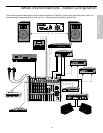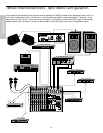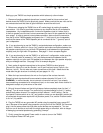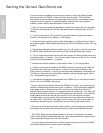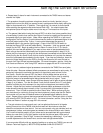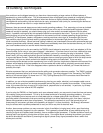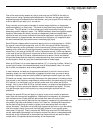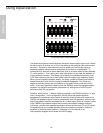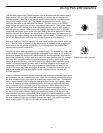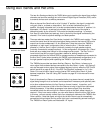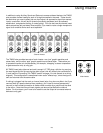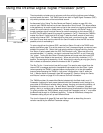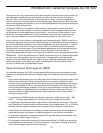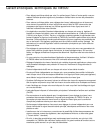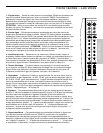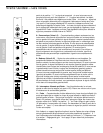
21
Using Pan and Balance
The final Main output of the TM500 is stereo—that is, there are discrete speaker output
jacks, labeled “left” and “right,” which will normally be routed to two (or two pairs of)
discrete speakers. Because of this, you will usually be working with a stereo field that
ranges from hard left to hard right. The TM500 provides eight monophonic input
channels, each with its own dedicated Pan control. The Pan circuitry in the TM500
always keeps the overall level constant, regardless of pan position. Here’s how it works:
When the Pan knob is placed at its center (detented) position, signal is sent equally to
both left and right outputs. When moved left of center, less signal is sent to the right
output and more signal is sent to the left output (making the sound appear left of center)
and when moved right of center, less signal is sent to the left output and more signal is
sent to the right output (making the sound appear right of center). To route a signal hard
left or right, place the pan knob either fully counterclockwise or fully clockwise.
Note that, when the TM500 is operated in a “split mono” configuration (that is, when the
Aux 1 / Monitor switch is pressed in), the stereo output is internally mixed to mono and
then routed to the left speaker outputs only. In this configuration, the channel Pan
controls are functionally inoperative.
You can use stereo panning creatively in a variety of ways: For example, you might want
to have guitars coming from one speaker and keyboards from another, or you might use
panning to “spread” the signal from a piano miked with two microphones—one over the
bass notes (panned left) and the other over the treble notes (panned right). By turning a
Pan knob while a signal is present, the sound appears to move in space (a process
known as
dynamic panning)—this can be particularly effective when applied to sound
effects. In live performance, you may want to resist the temptation to pan anything
completely hard left or right, since some members of the audience not seated in the
center of the venue may miss some signal altogether. In these circumstances, you’re
best to use modest panning, with signals routed no further than the 9 o’clock and
3 o’clock positions.
In stereo channels where both the odd-numbered (left) and even-numbered (right) inputs
are connected, the odd-numbered (left) input signal is automatically panned hard left and
the even-numbered (right) input signal is automatically panned hard right. The Balance
knob in these channels then controls the
relative levels of the two input signals. When
the knob is placed at its center (detented) position, both the odd-numbered (left) and
even-numbered (right) input signals are at equal strength. When moved left of center,
the signal of the odd-numbered (left) input remains the same but the signal of the
even-numbered (right) input is attenuated; when the knob is moved right of center, the
the signal of the even-numbered (right) input remains the same but the signal of the
odd-numbered (left) input is attenuated. When placed fully counterclockwise, only the
odd-numbered (left) input is heard (panned hard left); when placed fully clockwise, only
the even-numbered (right) input is heard (panned hard right). This actually sounds far
more confusing than it is—just try it out and it will make sense!
PAN
L
R
BALANCE
L
R
Pan knob (mono channels)
Balance knob (stereo channels)
ENGLISH



